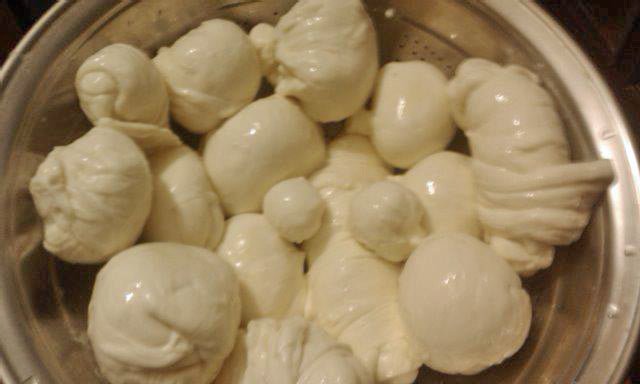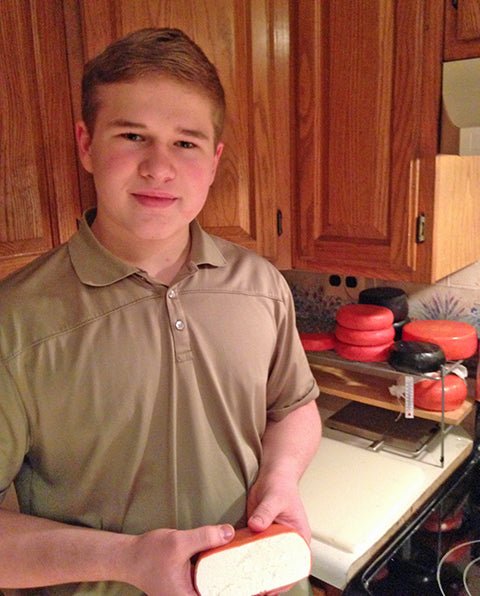She demonstrates this traditional method in both pictures and a video
This is our first blog article about bandage wrapping cheese, but it’s not our first article about Rashel. In fact, she was our “In the Spotlight” cheese maker for the January, 2013, Moosletter.
 |
| Rashel Harris with her Muensters |
So far, we have posted two blog articles about her – Rashel Harris in Palestine, Texas 2010 and Rashel Harris in Palestine, Texas 2013. She’s a master at home cheese making and she has shared her knowledge in 51 Youtube videos (see The Promiseland Farm- TriGirl123).
In her latest video,* she demonstrates several methods for coating a cheese before aging, including bandage wrapping.
Bandaging is most often used with Cheddar because it results in a drier, flakier cheese. (If you love the “crunch” in a well aged Cheddar, this is the technique for you!) The flavor is also strongly enhanced by the bandage wrap, because the molds (on the outside of the cheese) eat the fat on the bandage (and not the cheese).
Bandage Wrapping / Clothbound
Taken from – Part 8: How to Prepare Hard Cheese for Aging
By Rashel Harris at The Promiseland Farm
 |
| Young 4 month old clothbound Cheddar made with cheesecloth and lard |
Simple and excellent method! Bandage wrapping is my favorite way to protect hard cheese while aging. All you need is lard (liquid pig fat), tallow (liquid bovine fat) or butter and fabric!
You can bandage wrap any cheeses that has salted curds, such as Cheddar and Jack. Bandage wrapping allows the cheese to breathe! Traditionally, cheese was never waxed with paraffin (cheese wax), painted with cream or trapped in plastic.
STEP ONE FOR CLOTHBOUND CHEESE:
Slowly, melt and liquefy fat. You can use tallow, lard or butter.
I store my fat in the freezer and take it out the night before I want to use it. Then I put that whole quart jar of solid fat in a pot of water with a fabric napkin underneath. Put the heat on LOW… let it warm until it’s completely liquified, it takes a while, don’t watch the pot.
Take a look at my post on how to render your own lard and tallow if you don’t already have a stash of this liquid gold in your freezer.
STEP TWO FOR CLOTHBOUND CHEESE:
Cut up four squares from a tightly woven cheesecloth. The sides needs to hang halfway down the side of the cheese (see video* in this post for questions). Everyone’s mold is different, but my size is about a 10” x 10” square.
 |
| Rashel’s assistant helping her cut cheesecloth for clothbound Cheddar. |
STEP THREE FOR CLOTHBOUND CHEESE:
Make sure there is no mold that’s accumulated on the outside of your cheese. It’ll probably be a white color. If there is, gently wipe off the mold with a 3% salt solution of water (1/2 gallon), 2 Tbs vinegar and salt (1/2 cup), I keep this mixture in my cheese cave and use it to wipe cheese. Also, make sure that your cheese has air dried for 7-10 days and the cheese surface is completely dry.
Using your hands, dip them in the melted fat (make sure it’s not too hot, it should just be warm not hot) and smear the fat all over the cheese.
STEP FOUR FOR CLOTHBOUND CHEESE:
Take one of your cheesecloth squares and put it in the fat, then squeeze out the extra liquid from the cloth. Put that square on top of your cheese and press it down evenly on all sides.
Then flip the cheese over and do the same thing to the other side. Then flip over again and do another and flip and another. You want two layers of cheese cloth.
 |
| Tallow covered clothbound Cheddar, ready for the cave! |
STEP FIVE FOR CLOTHBOUND CHEESE:
At about one month, you’ll start to see mold growth on the outside of the bandage wrap, this is good! You can gently brush to distribute the mold. You can use a nail brush or soft bristled boar or horsehair brush. Brushing will not eliminate the mold growth, but it slows it down and spreads it out evenly.
When brushing your bandage, you want to brush away from the cheese. Do not brush in a circular motion. You’re trying to move the mold off the cheese and spread the mold out to prevent the mold from making big patches.
There’s no rule for when to brush cheeses. I try to brush my wheels about once every other week.
Make sure to throughly sanitize your brushes before and after use with a bit of bleach and water, then throughly rinse the bleach off. If I’m short on time, I put my brushes in the dishwasher top rack.
Do not use your cheese brushes for anything else except cheese!
When your cheese is done aging, remove the bandage and discard it. If the outside of your cheese has quite a bit of mold, you can wipe it off with that 3% brine solution mentioned above. Slice cheese and enjoy!
Rashel’s video*
How to Prepare Hard Cheese for Aging (Part 8 Cheesemaking Series)
Note: Rashel discusses a few other ways to prepare a cheese for aging before she gets to the bandaging part.















































































































































